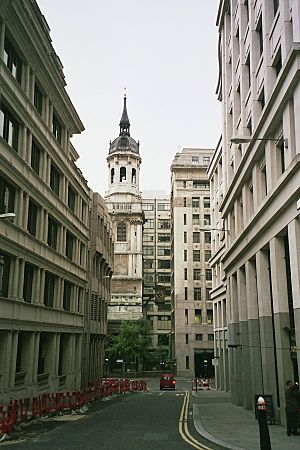Sir James Sanderson, 1st Baronet facts for kids
Quick facts for kids
Sir James Sanderson
|
|
|---|---|

St Magnus-the-Martyr church, where Sanderson is buried
|
|
| Born | 30 December 1741 York, Yorkshire, England
|
| Died | 21 June 1798 (aged 56) |
| Resting place | St Magnus-the-Martyr church in the City of London |
| Nationality | English |
| Occupation | Politician, social reformer |
| Employer | Sanderson & Co, Southwark |
| Known for | Lord Mayor, Social reform |
| Title | Baronet of the City of London |
| Spouse(s) |
|
| Parent(s) | James Sanderson |
Sir James Sanderson, 1st Baronet (born December 30, 1741 – died June 21, 1798) was an important English banker and politician. He served as a Member of Parliament and held the high office of Lord Mayor of London. He was also involved in social reform, helping to improve institutions for those in need.
After his death, his wife married William Huntington S.S., a preacher. Huntington used his new wealth to build a large chapel.
Contents
Sir James Sanderson's Early Life and Career
James Sanderson was born in 1741 in York, England. He was the only son of James Sanderson. He started his career by buying and selling hops, which are used to make beer. Later, he became a successful banker in Southwark, London.
Becoming a Leader in London
In 1785, Sanderson was elected Sheriff of London. This was an important role in the city's government. While serving as Sheriff, he was knighted, which means he was given the title "Sir."
In 1792, he achieved an even higher position. He was elected Lord Mayor of the City of London. This was a challenging time because of the French Revolution. People believed that a strong and wise leader like Sanderson was needed to guide the city.
Serving in Parliament
In the same year, 1792, Sanderson also became a Member of Parliament for Malmesbury. This meant he helped make laws for the country. Later, he became a Member of Parliament for Hastings. He became good friends with William Pitt the Younger, who was a very important politician at the time.
Helping Others: Social Reformer
Sir James Sanderson was known for his work in social reform. He wanted to help people who were struggling.
Leading Bridewell Hospital
In 1793, Sanderson became the president of Bridewell Hospital. This institution was a mix of a prison and a school for poor people. Sanderson greatly improved how it was run. Over time, the hospital's two roles were separated. The school part eventually became King Edward's School, Witley.

Working with William Wilberforce
Sanderson was also a member of the Proclamation Society. This group was started by William Wilberforce, who was famous for fighting against slavery. The society aimed to encourage good behavior and discourage bad actions. Sanderson was also involved with other charitable groups, like the Philanthropic Society and the Magdelen Hospital.
Later Life and Legacy
On December 6, 1794, James Sanderson was given the title of Baronet of London. This made him Sir James Sanderson, Baronet.
Sir James Sanderson was married twice. His first wife was Elizabeth Judd. His second wife was Elizabeth Skinner. His daughter, Elizabeth Skinner Sanderson, passed on his name to his grandson, Sir John Burdon-Sanderson, who became a doctor. Sir James Sanderson wanted his family to continue using his surname.
A painting of Sir James Sanderson was placed in the court room of Bridewell Royal Hospital. His memorial is at St Magnus-the-Martyr church in London.
After Sir James Sanderson died in 1798, his widow married William Huntington S.S.. Huntington was a preacher who built a new chapel that cost a lot of money.
Works
- Observations and examples to assist magistrates in setting the assize of bread made of wheat ... 1759

